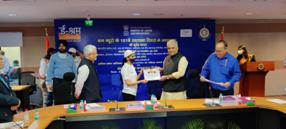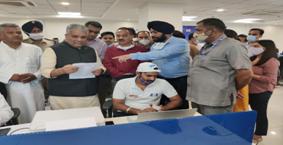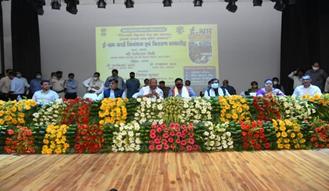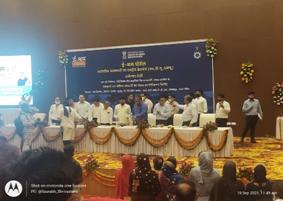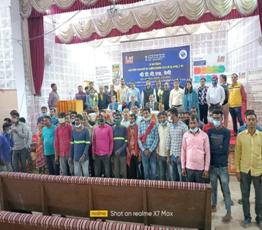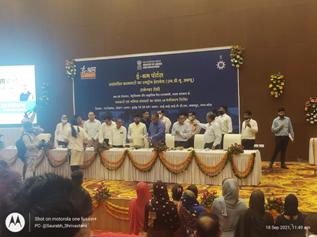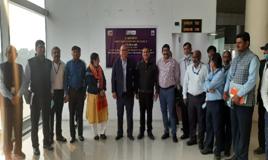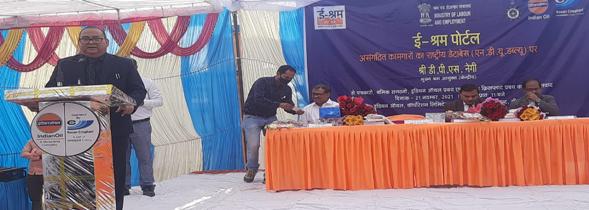Hong Kong – 18th round of computer ballot registration for submitting applications for Northbound Travel for Hong Kong Vehicles to open January 15 to 18
18th round of computer ballot registration for submitting applications for Northbound Travel for Hong Kong Vehicles to open January 15 to 18
******************************************************************************************
The Transport Department today (January 14) reminded members of the public that the 18th round of computer ballot registration for submitting applications for Northbound Travel for Hong Kong Vehicles (the scheme) will be open from 10am tomorrow (January 15) to 11.59pm on January 18, and the ballot result will be announced on January 19.
Eligible applicants for the scheme can register for computer balloting through the designated website (www.hzmbqfs.gov.hk). Successful balloting applicants are required to submit applications for the scheme within the designated date and time randomly allocated by the computer system.
HYAB launches new round of United Nations Volunteers – Hong Kong Universities Volunteer Internship Programme
******************************************************************************************
On the closing night of 20 January, CIMC (000039.SZ) released 2022 results forecast. During the reporting period, net profit attributable to the parent was RMB3 billion to RMB3.8 billion, and net profit attributable to the parent after deducting non-recurring gains and losses was estimated to be RMB3.6 billion to RMB5.2 billion. There exited a certain gap for the figures compared with the same period last year, which however is within the expected range. Combined with the recent trend of container transportation industry plus the figures released in the third quarter of last year, it can be found that the gap has been fully digested by the market. High-quality growth ideas of “container leader”: seeking new growth points in the future through innovation What is the development concept of high-quality growth? In order to change its stereotype in the market, CIMC, as the “container leader” in the world, is planning to maintain and improve its existing product advantages and build a model enterprise of operational excellence by strengthening technological innovation, creating smart products and promoting intelligent manufacturing. It is easy to see that CIMC’s new round of growth in the future is inseparable from technological innovation, continuous upgrading of manufacturing capabilities and models, improvement in strengths of product and service capabilities, as well as superior operational management mode of lean management and quality improvement and efficiency increase. Historically, CIMC has been a company committed to sustainable growth. In recent years, the reason why CIMC has been able to achieve steady growth and survived cyclical turbulence in an erratic and complex external environment is, in short, continuous seeking of new future growth points based on its original pillar businesses, solid development of its rooted industries and release of its leading advantages. Today, CIMC’s innovative businesses are showing multiple points of development, which can be commendable and the results are beginning to emerge. They have beneficially complemented and linked to the original foundation, weakness or strength, enabling the expansion and integration of the Company’s businesses and the enhancement of its comprehensive strength to be rolled out smoothly in a better way. Meanwhile, CIMC’s continued exploration of innovative businesses will be a strong booster for its future “high-quality growth”. As we all know, CIMC is a leading global supplier of equipment and solutions for the logistics and energy industries, with its industrial clusters mainly covering the logistics and energy sectors. One of the key cores supporting its development in the two sectors is CIMC’s advanced production modes and manufacturing capabilities. However, any manufacturing industry cannot do without full support and coordination of the upstream and downstream of the value chain. Following these three directions, let’s take a look at how CIMC has developed its innovative businesses. The first arrow of innovative businesses was shot at clean energy, yielding unusually brilliant results in niche main tracks Nowadays, energy storage has become an indispensable part of new energy power generation and also one of the key technologies for countries to advance their carbon neutrality goals. As a result, the energy storage industry is considered to be the most certain golden track in the new energy industry. At the moment, a research report published by the institute of Essence Securities believes that the global energy storage industry may usher in a greater boom in 2023, which concludes from the revenue, cost and policy that stimulus for such energy storage boom may have been ready. From the policy, the current rapidly growing demand for energy storage installations in the PRC is mainly attributable to policy requirements for new energy installations. Local governments require that new energy installations shall be mandatorily equipped with a certain percentage of energy storage devices. For example, Hunan Province requires wind power and centralised photovoltaic power generation to be equipped with no less than 15% energy storage devices, while Shanghai requires offshore wind power to be equipped with no less than 20% energy storage devices. Other provinces and cities require the allocation of energy storage for new energy installations ranging from 2% to 20%. The “Energy Storage Industry Research White Paper 2022” points out that the new energy storage will grow at a CAGR of 53.3% from 2022 to 2026, showing a steady and rapid growth of the energy storage market. Given multiple certainties in the development of energy storage industry, CIMC has leveraged its strength to enter the energy storage track in order to capture the industry’s strong and sustainable growth momentum in future. In the author’s view, since 2021, CIMC’s container integrated business has been carrying out energy storage related business. In 2021, CIMC’s container integrated equipment business continued with rapid growth and forged closer cooperation with the industry’s leading customers. Its integrated energy equipment business mainly focuses on four aspects: new energy power transformation equipment, power generation equipment, electrochemical energy storage equipment and new energy charging equipment. Among them, new energy power transformation and energy storage equipment is the key business development direction for the container segment in the future. On 16 November 2022, Fujian CIMC New Energy Technology Co., Ltd. was established, which is a company indirectly wholly owned by CIMC, and its business scope includes energy storage technology services; centralized fast charging stations; manufacturing of new energy primary power equipment; sales of batteries and others. It may indicate that CIMC will fully accelerate its presence in the energy storage industry chain. From 2023 onwards, it is believed that in the energy storage sector, CIMC will also be able to bring into play its extensive experience and industrial advantages, such as in its container integrated equipment business. This will further fit its ongoing promotion of the “parity programme” of offshore wind power, thus making up the last “short board” of its innovative businesses in the new energy industry. It is worth noting that CIMC has established its core advantages in the key parts of hydrogen energy industry chain. CIMC is fully accelerating its presence and development of hydrogen energy, and from the Group as a whole, CIMC Enric is one of the leading players in hydrogen energy development. With storage equipment, transportation equipment and hydrogen refueling equipment being its major business areas, the company aims to become a leader in the key parts. It is reported that CIMC Enric has become one of the major suppliers of third generation hydrogen storage cylinders and has formed a joint venture with HEXAGON, a world class supplier of Type IV (“T4”) hydrogen cylinders and system technology and design, which will provide the production, storage and transportation solutions of Type III and T4 hydrogen storage cylinders for the fast-growing high-pressure hydrogen storage and transportation in China and Southeast Asia, as well as the production of hydrogen supply systems. With the construction of hydrogen refueling stations in China expected to usher in a period of rapid development, CIMC Enric will seize the opportunity of new construction demand for hydrogen refueling stations and explore the development of new models such as skid-mounted hydrogen refueling stations and integrated hydrogen production and refueling stations. In fact, as early as 2006, CIMC Enric, the representative of CIMC tapping into the field of hydrogen energy, started to deploy its hydrogen energy business. After more than 20 years of accumulation, CIMC has established a profound foundation in the upstream and downstream of the hydrogen energy industry chain, and CIMC Enric has deservedly become the pioneer of CIMC’s hydrogen energy business. Once the hydrogen energy track continues to boom in China in the future, CIMC Enric’s leading position in hydrogen energy storage and transportation, as well as its growth potential, will be released accordingly. The second arrow of innovative businesses was shot at cold chain logistics, with CIMC Cold Chain releasing huge growth potential The cold chain logistics industry, which connects primary, secondary and tertiary industries, is an important industry to effectively link up rural revitalization and promote consumption upgrade. Since the end of 2021, certain policies in relation to the domestic cold chain logistics sector have continued to be implemented. The 14th Five-Year Plan for the Development of Cold Chain Logistics clearly states that by 2025, China will initially form a cold chain logistics network that links the production and sales places, covers urban and rural areas, and connects the markets at home and abroad. Since 2022, many provinces and cities across the country have also issued relevant policies to support the development of cold chain logistics. The policy effort is expected to bring significant changes and improvements to the supply side of the domestic cold chain logistics industry, and the pandemic period of the past three years has also fundamentally accelerated the shift in demand across the industry. Whether imported or domestic, China’s cold chain logistics industry is experiencing its most flourishing period. By the end of 2020, the domestic cold chain logistics market size exceeded RMB480 billion, with a cold storage capacity of approximately 180 million cubic meters and a refrigerated van fleet of more than 280,000 vehicles. As for food cold chain accounting for up to 90% in the market, its overall penetration rate was approximately 40%, and compared to the 80-90% penetration rate in developed countries (such as Japan and the United States), there was still a potential growth space of one or more times. In 2019, before the outbreak of the COVID-19 pandemic, China’s medicine cold chain accounted for approximately 9%, corresponding to approximately RMB13 billion cold chain logistics market. In the medium and long term, the continuous expansion of the medicine market, including vaccines, may drive the rapid growth of the medicine cold chain industry. Once the penetration rate reaches 40-50%, it represents an incremental space of RMB40-50 billion in cold chain logistics. In addition, in terms of the cold chain transportation rate of agricultural products in China, there is still a large room for improvement compared with the rate of 80%-95% in developed countries. The shortage of cold chain transportation rate also causes a high spoilage rate of agricultural products. For example, the spoilage rate of fruits and vegetables in China is approximately 15%, far higher than the average level of 5% in developed countries. All of these are issues in urgent need to be resolved in the cold chain logistics, which in turn bring huge opportunities for development to them as well. By and large, the scale of China’s cold chain logistics industry, also as a development direction with higher certainty, will reach trillion in RMB taking the long view. As the most critical link with the highest technical content in cold chain logistics, cold chain equipment assumes an irreplaceable role. This is because in every link of cold chain logistics, namely from the “first kilometer”, “circulation and transportation” to the “last kilometer”, appropriate cold chain equipment shall be allocated to ensure refrigeration and freezing throughout the process. Especially in the medicine cold chain, in order to ensure the entire circulation process of drugs always within a specific temperature range, it has a strict operational process in the medicine cold chain transportation, with more stringent requirements on temperature control, temperature fluctuations monitoring and other aspects throughout the process. Since CIMC set up its first reefer container company in Shanghai in 1995, after 27 years of engagement in the industry, CIMC has become the largest global high-end cold chain equipment solution provider with a wide coverage and complete industrial chain, gradually forming a comprehensive layout of cold chain equipment by land, sea and air. In 2017, in order to expand and improve its strategic business chain of cold chain equipment, CIMC successfully incubated a “dual-innovation” enterprise, CIMC Cold Chain, which leverages CIMC’s technological and manufacturing advantages in marine reefer containers and refrigerated vans to develop portable cold store business. At the end of 2020, CIMC Cold Chain formally introduced external strategic investors and embarked on a new “fast track” of development, focusing on the layout of multi-functional modularized reefer container business in the “first kilometer” and “last kilometer” of agricultural products and fresh food e-commerce. The portable cold store, as the main business of CIMC Cold Chain, is an important part of CIMC’s development strategy in the cold chain industry. Urbanization and new consumption patterns such as e-commerce have had a profound impact on the cold chain industry. The centralized cold chain model, with large cold stores and traditional supermarkets as the main nodes, will also convert to a distributed cold chain model with field locations, transportation network nodes and urban front-end warehouses. Under new opportunities from the rapid industrial development of China’s cold chain, CIMC Cold Chain has actively developed and promoted “new technologies, new equipment and new models” to accelerate industrial changes, improve the efficiency and quality of the cold chain industry, and lead the cold chain logistics industry to a new leap forward, thus becoming the leader of distributed cold chain equipment in China. The third arrow of innovative businesses was shot at new materials, with CIMC Bamboo Chain Technology Co. and CIMC Composites Co. emerging It is, therefore, not difficult to understand why the third arrow of CIMC’s innovative businesses has been shot selectively at the new materials industry. Like the semiconductor industry, the upstream materials and equipment sector has always been at the very top of the pyramid, and that whoever controls the key manufacturing materials and equipment, it is sure to grasp the lifeblood and future of numerous industries. We have identified CIMC Bamboo Chain and CIMC Composites as the very representative of CIMC’s pioneers in the new materials field. CIMC Bamboo Chain Technology Co., Ltd. has the world’s exclusive technology in the biodegradable material industry, which means that plants (such as bamboo, reeds, etc.) can be used to produce low-carbon biodegradable products (generally renewable fibers or powder) through purely physical treatment, with no chemical treatment required throughout the production process, greatly reducing water consumption and chemical pollution. According to the announcement, on 11 November 2022, CIMC Bamboo Chain Technology Co., Ltd. signed a cooperation framework agreement with Yueyang Economic and Technological Development Zone Management Committee. According to the agreement, CIMC Bamboo Chain Technology will actively promote the construction of the CIMC New Renewable Fiber Industrial Park project in Yueyang Economic and Technological Development Zone, which will use the instant catapult steam explosion technology, an exclusive global technology owned by CIMC Bamboo Chain, to produce plant fibers/powder. This move may become another milestone event in the industrialization and commercialization of patents in CIMC’s innovative businesses, which also means that it will be able to bring more value, increase new sources of revenue and improve the utilization of patents within the Company, as well as enhance the efficiency of the innovation transformation results. When it comes to Qingdao CIMC Composites Co., Ltd., it has been aiming to become a leader in the thermoplastic composite industry since its inception in 2018. In July 2022, CIMC Composites was successfully listed on the list of provincial-level “Specialized and New” enterprises in 2022 by the Department of Industry and Information Technology of Shandong Province with its innovative development in the field of thermoplastic composites. In the context of promoting energy conservation, emission reduction and green low-carbon, CIMC Composites has mastered the core technology to produce continuous fiber reinforced thermoplastic composites (CFRT) with the unique attributes of “light weight and high strength”. The refrigerated van produced with this new material has no odor, and also has the characteristics of water, moisture, corrosion and impact resistance. It is a complete alternative to the traditional FRP material, which emits a constant pungent odor and produces large quantities of formaldehyde and benzene during the manufacturing process. In addition, this continuous fiber reinforced thermoplastic composite (CFRT) and its processed products can be recycled an unlimited number of times, which is very beneficial to the environment and is in line with trend of low-carbon environmental protection advocated by the global industry. Based on the above advantages, this new material is now used in a large number of refrigerator vans produced by the Shandong base of CIMC refrigerator vans and in the refrigerator van products of major brands across China. With the development of national economy and the progress of new material technology, this kind of thermoplastic composite material with the advantages of light weight and environmental protection has been more and more widely used in the fields of transportation, pressure pipeline, construction and household, etc. It will also become an important driver for upgrading more industries in the future, with huge development potential and a broad market space. Leveraging the advantage of innovative technology, CIMC Composites has become one of the fast-growing enterprises in the domestic new materials industry, and has developed into a national high-tech enterprise in less than four years, with an annual output value of over RMB100 million, successfully developing more than 30 new products and maintaining the momentum of rapid business growth. Through the “emergence” of CIMC Bamboo Chain and CIMC Composites, CIMC has opened up a new development stage of “from 1 to 100” in several promising segments of the new materials industry, directly bringing a new hope of higher-level upgrading and alternative development to many industries from the upstream of the manufacturing and the source of technology. Finally, from the booming development momentum of CIMC’s innovative businesses, it can be concluded that as innovation is always the first driving force for development, CIMC will ultimately advance itself, its industry and society to new heights of high-quality development through the in-depth implementation of its innovation-driven development strategy. There is no doubt that this idea and determination are correct, and the results of its practice will eventually prove that victory will be on the side of human progress and evolution. The future of CIMC is bound to be promising, and the take-off of CIMC will surely be seen again. Sectors: Marine & Offshore http://www.acnnewswire.com Copyright © 2023 ACN Newswire. All rights reserved. A division of Asia Corporate News Network.Hong Kong – HYAB launches new round of United Nations Volunteers – Hong Kong Universities Volunteer Internship Programme
The Home and Youth Affairs Bureau (HYAB), in partnership with the United Nations Volunteers, the Agency for Volunteer Service (AVS), the Hong Kong Volunteers Association and the Peace and Development Foundation, today (December 22) launched a new round of the United Nations Volunteers – Hong Kong Universities Volunteer Internship Programme. Local undergraduate students are welcome to apply.
The Government attaches great importance to youth development. The HYAB promulgated the Youth Development Blueprint at the end of 2022. It states that the Government will further strengthen the breadth and depth of the Mainland and international internship and exchange programmes with a view to enhancing young people’s understanding of the development of the country and the world. The Programme provides local undergraduate students with valuable opportunities to undertake six-month volunteer internships in the overseas field units of various United Nations (UN) agencies. The interns will be able to develop their personal capabilities and expand their horizons, as well as contribute to the international community in the capacity of Chinese youth volunteers. A total of 23 university students participated in two rounds of the Programme in 2023 and undertook internships in various UN agencies located in Indonesia, Malaysia, Nepal and Thailand, including the World Food Programme, UN Children’s Fund and UN Educational, Scientific and Cultural Organization, etc. They made contributions to different international affairs and were greatly rewarded from the experience.
The new round of the Programme will be expanded to cover more countries along the Belt and Road region, offering a total of 25 internship placements in different UN agencies located in Armenia, Kazakhstan, Indonesia, Nepal, Thailand, Uzbekistan and Vietnam, etc. The volunteer internships will cover areas such as health and education, environment and innovation management and will run from July to December 2024. Applicants should be full-time undergraduate students of local universities. The HYAB will provide round-trip air tickets and monthly living allowances, etc, and offer suitable pre-departure training for participants in collaboration with the AVS.
Details of the Programme are available at the designated webpage (www.avs.org.hk/eng/UNV). Interested young people should submit applications on or before January 25, 2024.CIMC is betting on a new round of growth by shooting “triple arrows” of its innovative businesses
In addition, upon the release of the annual results alert, CIMC’s H shares also had a relatively stable and upward trend in trading sessions after the opening of the Hong Kong stock market in the Year of the Rabbit, with a cumulative increase of 2.76% in just two trading days, making a “good start”.
In the past year, despite the combined impact of multiple complex factors such as geopolitical incidents, rising inflation overseas, aggressive rate hikes in Europe and the United States, and slowdown of the global economy, CIMC has generally maintained a good momentum of “improving quality and increasing efficiency” and demonstrated strong business resilience, achieving steady progress. In 2023, CIMC has established and thoroughly implemented the new development concept, focusing on high-quality growth.
CIMC’s first arrow of developing innovative businesses in the energy industry was shot at clean energy. Among numerous niche tracks, it chose the two main tracks of energy storage and hydrogen energy respectively, achieving remarkable results by completing a critical layout with outstanding results, which laid a solid foundation for future growth.
As mentioned in the beginning, another pillar on which CIMC’s dominant industrial cluster focuses is the logistics sector. To this end, CIMC has shot its second arrow of innovative businesses at cold chain logistics.
According to the author’s understanding, the reason why CIMC has been able to establish its core competitive advantage of industrial clusters and accumulate a deep “moat” foundation in the energy and logistics fields is always inseparable from the advanced production modes and high-end manufacturing capabilities owned by CIMC. As mentioned, any manufacturing industry needs full support and cooperation of the upstream and downstream of the industry in order to achieve a real competitive advantage.
Topic: Press release summary
From the Asia Corporate News Network
All round efforts led by Union Minister Shri Bhupender Yadav yields huge success in registration at E-shram portal
The number of Unorganised Sector workers registration at the e-Shram portal has been rising steadily over the 12 weeks since its launch (as can be seen from the Figure below). As on 20th November 2021, which is more than 12 weeks since registration started, around 8,43,89,193 total number of unorganized workers have registered at the e-Shram portal, with an increase of 13,10,758 total workers registered the previous day.
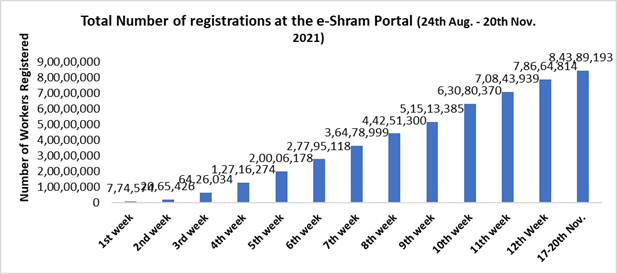
It is pertinent to observe that the huge success in registration in e-Shram portal is due to unified command and control and regular directions and meticulous monitoring by Shri Bhupender Yadav, Union Minister for Labour & Employment, Environment, Forest & Climate Change with the spirited co-operation of all the senior officers in the Ministry and the state governments along with the massive involvement of central trade union leaders and their state counterparts.
|
|
|
|
Shri Bhupender Yadav – Hon’ble Minister for Labour & Employment, Environment, Forest & Climate Change overseeing the work of e-Shram registration and giving appreciation letters to good workers of CSC. |
|
Union Minister Shri Bhupender Yadav, Shri Rameshwar Teli, Minister of State for Labour and Employment, Shri Sunil Barthwal, Secretary, Labour & Employment have been extensively mobilizing resources, organizing series of the awareness program and also special camp with concerted efforts of the Chief Labour Commissioner (Central), Shri D.P.S. Negi and his team of committed officers in various regions of the country by involving employers, trade union leaders, employees, state government and NGOs have helped in a big way. So far more than 60 mega camps have been organized.
|
|
|
|
Shri Rameshwar Teli, Minister of State for Labour and Employment, Petroleum & Natural Gas in the e-Shram awareness programme along with Shri D.P.S. Negi, Chief Labour Commissioner (Central) |
|
Week-wise data on the increase in number of registrations at the e-Shram portal over the previous 12 weeks since registration started on 24th August, recorded maximum increase of such registrations for the 10th week (2nd-8th November) – 1,15,66,985 registrations, followed by the 7th week (12th -18th October) – 86,83,881 registrations. As of now, in the past four days, i.e. from 17th to 20th November 2021, around 57,24,286 registrations have been recorded at the e-Shram portal (figure below).
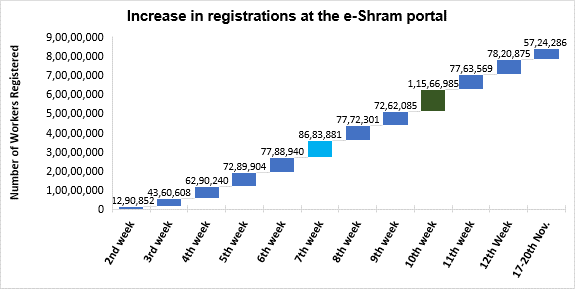
Registration at the e-Shram portal through CSC, Self or State Seva Kendras
The registrations of unorganised workers in the e-Shram portal can be through Common Service Centres (CSC), Self, or through State Seva Kendras. Maximum share of registrations is recorded for those registering through CSCs, followed by Self mode of registrations and minor share for State Seva Kendras. The number of CSC registrations at the e-Shram portal has been rising over the subsequent weeks to till date on 20th November with 6,77,14,523 registrations (figure below).
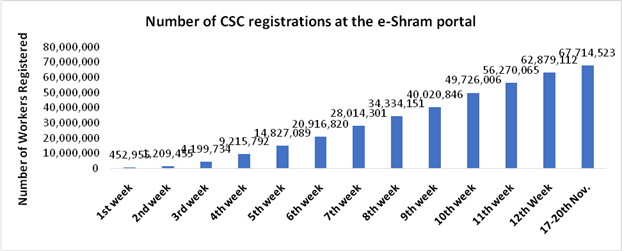
In the previous six weeks since 5th October 2021 onwards, a spike in registration of unorganised sector workers through State Seva Kendras has been recorded, with the largest such increase occurring in the preceding week (9th to 16th November 2021) and it almost doubling from 24,842 to 53,970 registrations. As on 20th November, the number of such registrations stands at 86,067.
The increase in registration of unorganised sector workers through CSC or Self mode of registrations particularly increased in India since 16th September onwards, and presently daily registrations of at least around 11 lakh are recorded through CSC registrations, around 2 lakh for Self-registration and almost 7 thousand for State Seva Kendras registrations, as of 20 th November 2021.
Out of total registrations, CSCs account for at least 60 % of such registrations and in the subsequent weeks its share has been increasing to around 80% presently as can be seen from the figure below.
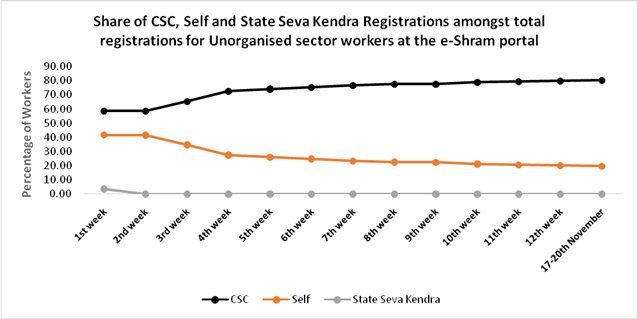
State-wise trend in registration of unorganised sector workers at the e-Shram portal
Over the past 12 weeks, the states of West Bengal, Odisha, Uttar Pradesh and Bihar have the highest average growth rates of more than 15% regarding the registration of workers at the e-Shram portal.
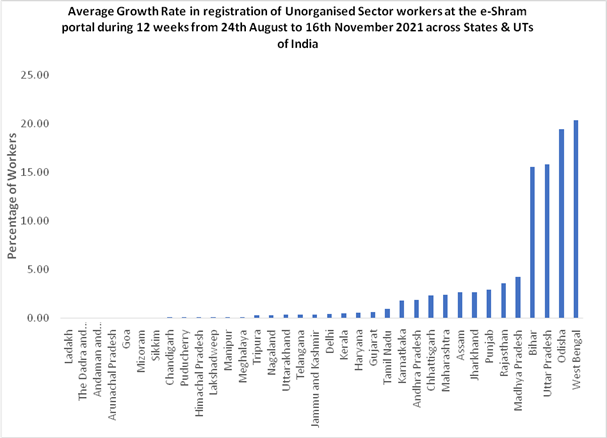
In the 12th week (9th to 16th November 2021) registrations at the e-Shram portal were particularly high for the states of Uttar Pradesh, West Bengal and moderately high in Chhattisgarh, Jharkhand, Punjab, Odisha and Bihar (figure below).
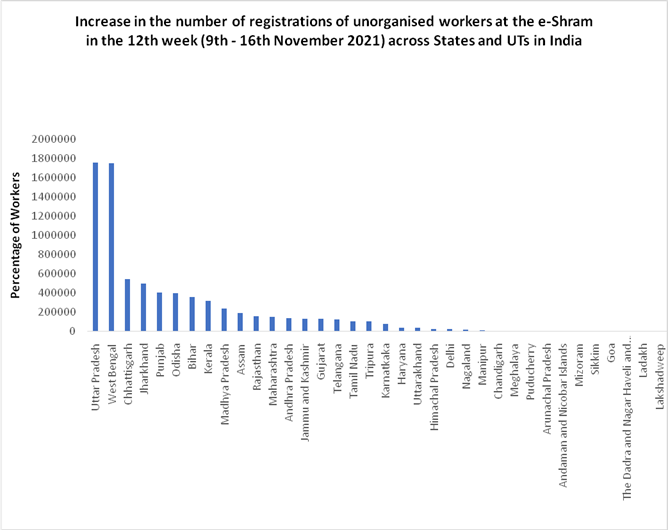
Occupation-wise trend in registration of unorganised sector workers at the e-Shram portal
With respect to total number of workers registered across occupational categories at the portal over 12 weeks from 24th August to 16th November 2021, the top five categories are Agriculture, Construction, Apparel, Automobile and Transportation and Household and Domestic Workers. The ranking of these occupational categories in terms of total number of registration has varied over time. Additionally, since the last month, Capital Goods and Manufacturing has ranked as the fifth most important occupational category (table below).
As of 20th November 2021, the top five occupational categories for workers registered in this portal are for Agriculture (53.2% and 4,48,76,425 registrations), Construction (12.1% and 1,02,58,713 registrations), Domestic and Household Workers (8.8% and 74,22,236 registrations), Apparel (6.3% and 52,89,110 registrations) and Capital Goods and Manufacturing (3.3% and 27,60,050 registrations). Agriculture is the main occupation for more than half of all registered workers, further two important sub-categories of Agriculture workers are ’Crop Farm Labourers’ and ‘Field Crop and Vegetable growers’ (with nearly 20 lakhs registrations on 20th November 2021).
The top five occupational categories of women unorganised sector workers registered on the portal are Agriculture (2.1 crores), Domestic and Household workers (71 lakhs), Apparel (46 lakhs), Construction (23 lakhs) and Miscellaneous (17.98 lakhs). Correspondingly, the top five occupational categories for male workers are Agriculture (2.3 crores), Construction (78 lakhs), Automobile & Transportation (22.1 lakhs), Capital Goods and Manufacturing (18.9 lakhs) and Miscellaneous (7.7 lakhs).
Table showing major Occupational Groups of registered unorganised sector workers at the e-Shram portal over the previous 12 weeks (24th August – 16th November 2021)
|
Top 5 Occupational categories for workers registering at the e-Shram portal |
|||||
|
Week |
1st |
2nd |
3rd |
4th |
5th |
|
1st |
Agriculture |
Construction |
Apparel |
Automobile & Transportation |
Domestic and Household Workers |
|
2nd |
Agriculture |
Construction |
Apparel |
Domestic and Household Workers |
Automobile & Transportation |
|
3rd |
Agriculture |
Construction |
Domestic and Household Workers |
Apparel |
Automobile & Transportation |
|
4th |
Agriculture |
Construction |
Domestic and Household Workers |
Apparel |
Automobile & Transportation |
|
5th |
Agriculture |
Apparel |
Automobile & Transportation |
Beauty & Wellness |
BFSI |
|
6th |
Agriculture |
Construction |
Domestic and Household Workers |
Apparel |
Automobile & Transportation |
|
7th |
Agriculture |
Construction |
Domestic and Household Workers |
Apparel |
Automobile & Transportation |
|
8th |
Agriculture |
Construction |
Domestic and Household Workers |
Apparel |
Automobile & Transportation |
|
9th |
Agriculture |
Construction |
Domestic and Household Workers |
Apparel |
Capital Goods & Manufacturing |
|
10th |
Agriculture |
Construction |
Domestic and Household Workers |
Apparel |
Capital Goods & Manufacturing |
|
11th |
Agriculture |
Construction |
Domestic and Household Workers |
Apparel |
Capital Goods & Manufacturing |
|
12th |
Agriculture |
Construction |
Domestic and Household Workers |
Apparel |
Capital Goods & Manufacturing |
Distribution of unorganised sector workers registered at the e-Shram portal by age-groups, income groups and financial inclusion
Age-group wise composition of unorganised sector workers registered at the portal in the last 12 weeks shows that the workers in the age group of ‘18-40’ have the highest share, followed by those in the age-group ‘40-50’ (figure below). Average weekly share of registrations across different age groups is highest for workers in the age-group of ’18-40’ followed by those in the age-group of ‘40-50’ (63 and 21 percentages respectively).
With respect to total number of registrations since the launch of the portal, the number of registrations for the workers in the age-group of ’18-40’ has increased from about 5 lakhs in the first week of the launch of the portal to about 4.8 crores in the 12th week (10th-16th November).
On 20th November 2021, the total number of registrations has reached 5 crore (5,17,42,315) in the age-group of ’18-40’ and 1.8 crore (1,88,18,074) in the age-group of ’40-50’.
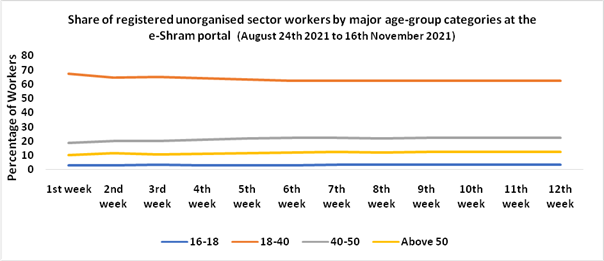
Gender-wise analysis of e-Shram portal registrations indicates that during the first six weeks after the launch of the portal, among the workers getting registered, the share of male workers was slightly higher (more than 51%). However, in the last six weeks the share of females workers has become higher as compared to the male workers (figure below). Thus, a shift is being observed in more female workers as compared to the male workers getting registered on the portal. By 20th November, out of the total registrations, 48.2% (4,06,86,429) were male workers and 51.8 % (4,37,00,713) female workers.
In the first week of registration, of the total workers getting registered, around 5 lakhs were males and about 2.7 lakh were females. This has increased to 3.8 crore registrations for males and 4.05 crore registrations for females in the 12th week (10th -16th November).
The registration for the ‘Others’ in terms of gender, at the e-Shram portal has been slow, with around 2,095 total registrations completed by 20th November.
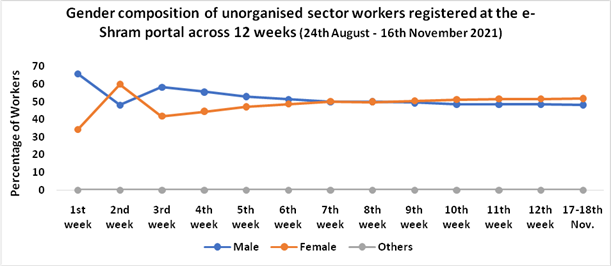
While registering at the e-Shram portal, the unorganised sector workers can furnish details of their bank accounts along with nominee details, to get benefits from government schemes linked with the registration on the portal, such as accident covers in case of death or disability or partial disbaility. Having details of both bank account and nominee details is an important aspect of this scheme and its integration with labour and other social welfare schemes formulated by the government.
Initially, a lower share of workers getting registered at the portal were providing details of their bank accounts. However, this share has gone substantially up, from 47% in the first week to 86.3% in the 12th week (figure below). Additionally, nominee details of the workers getting registered at the portal were provided by only 38% of workers in the first week and 88% in the 12th week.
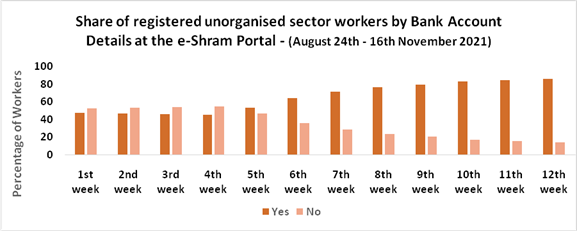
Income-group wise analysis of workers registering at the portal shows that on an average 91% of the total workers registered are in the monthly income slab of less than Rs. 10000. The share of workers in the monthly income slab of Rs. 21000 and above is just 0.61%. The proportion of workers from the income slab of Rs 10000 has increased from 86% in the first week to about 92% in the 12th week.
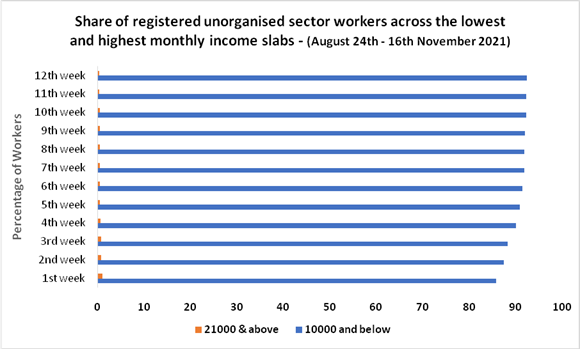
|
|
|
|
|
|
|
|
|
|
Shri D.P.S. Negi, Chief Labour Commissioner (Central) along with Deputy Chief Labour Commissioner Shri R.K. Agarwal and other officers discussing about the e-Shram portal to the employees, trade union leaders, workers, media at Varanasi and Gorakhpur on 20th and 21st November 2021. |
|
In continuation of the outreach efforts, Shri D.P.S. Negi led the team and organized four awareness programmmes-cum -registration camps with airlines (Air India, Vistara, SpiceJet, Indigo, Go Airways), CISF, gig and platform workers and Airport Authority of India at Varanasi, CPWD, Central PSUs (SPCL, BPCL, Indian Oil) at Varanasi and Gorakhpur from 19th to 21st November 2021.
***
GK
(Release ID: 1773750)
Visitor Counter : 438

